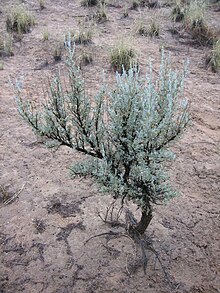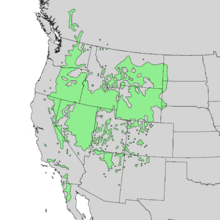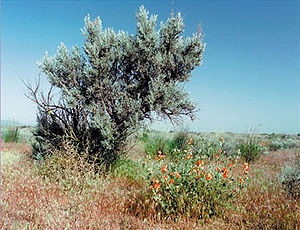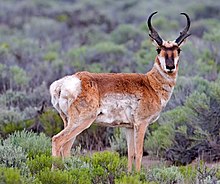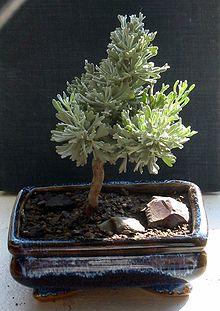
The greater sage-grouse, also known as the sagehen, is the largest grouse in North America. Its range is sagebrush country in the western United States and southern Alberta and Saskatchewan, Canada. It was known as simply the sage grouse until the Gunnison sage-grouse was recognized as a separate species in 2000. The Mono Basin population of sage grouse may also be distinct.

The Great Basin Desert is part of the Great Basin between the Sierra Nevada and the Wasatch Range. The desert is a geographical region that largely overlaps the Great Basin shrub steppe defined by the World Wildlife Fund, and the Central Basin and Range ecoregion defined by the U.S. Environmental Protection Agency and United States Geological Survey. It is a temperate desert with hot, dry summers and snowy winters. The desert spans large portions of Nevada and Utah, and extends into eastern California. The desert is one of the four biologically defined deserts in North America, in addition to the Mojave, Sonoran, and Chihuahuan Deserts.

Artemisia is a large, diverse genus of plants belonging to the daisy family Asteraceae, with between 200 and 400 species. Common names for various species in the genus include mugwort, wormwood, and sagebrush.

Sagebrush steppe is a type of shrub-steppe, a plant community characterized by the presence of shrubs, and usually dominated by sagebrush, any of several species in the genus Artemisia. This ecosystem is found in the Intermountain West in the United States.

The pygmy rabbit is a rabbit species native to the United States. It is also the only native rabbit species in North America to dig its own burrow. The pygmy rabbit differs significantly from species within either the Lepus (hare) or Sylvilagus (cottontail) genera and is generally considered to be within the monotypic genus Brachylagus. One isolated population, the Columbia Basin pygmy rabbit, is listed as an endangered species by the U.S. Federal government, though the International Union for Conservation of Nature lists the species as lower risk.

Frangula californica is a species of flowering plant in the buckthorn family native to western North America. It produces edible fruits and seeds. It is commonly known as California coffeeberry and California buckthorn.

Shrub-steppe is a type of low-rainfall natural grassland. While arid, shrub-steppes have sufficient moisture to support a cover of perennial grasses or shrubs, a feature which distinguishes them from deserts.
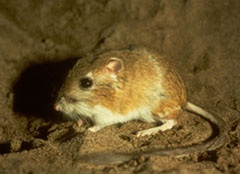
Ord's kangaroo rat is a kangaroo rat native to western North America, specifically the Great Plains and the Great Basin, with its range extending from extreme southern Canada to central Mexico.

Ranunculus glaberrimus, the sagebrush buttercup, is a species of flowering plant in the buttercup family, Ranunculaceae. It is native to interior western North America, in western Canada, the western United States, and the northwestern Great Plains.

Townsend's ground squirrel is a species of rodent in the family Sciuridae. It is found in high desert shrublands in several areas of the United States.

The black-tailed jackrabbit, also known as the American desert hare, is a common hare of the western United States and Mexico, where it is found at elevations from sea level up to 10,000 ft (3,000 m). Reaching a length around 2 ft (61 cm), and a weight from 3 to 6 lb, the black-tailed jackrabbit is one of the largest North American hares. Black-tailed jackrabbits occupy mixed shrub-grassland terrains. Their breeding depends on the location; it typically peaks in spring, but may continue all year round in warm climates. Young are born fully furred with eyes open; they are well camouflaged and are mobile within minutes of birth, thus females do not protect or even stay with the young except during nursing. The average litter size is around four, but may be as low as two and as high as seven in warm regions.

Artemisia arbuscula is a North American species of sagebrush known by the common names little sagebrush, low sagebrush, or black sagebrush. It is native to the western United States from Washington, Oregon, and California east as far as Colorado and Wyoming. It grows in open, exposed habitat on dry, sterile soils high in rock and clay content.

Artemisia nova is a North American species of sagebrush, known by the common name black sagebrush. It is "one of the most common shrubs in the western United States".

Chrysothamnus viscidiflorus is an American species of shrub in the family Asteraceae known by the common names yellow rabbitbrush and green rabbitbrush.
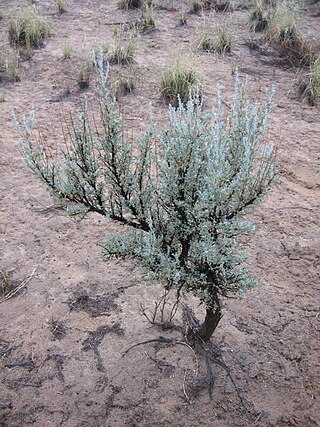
Sagebrush is the common name of several woody and herbaceous species of plants in the genus Artemisia. The best known sagebrush is the shrub Artemisia tridentata. Sagebrushes are native to the North American west.
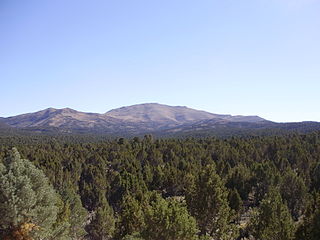
Pinyon–juniper woodland, also spelled piñon–juniper woodland, is a biome found mid-elevations in arid regions of the Western United States, characterized by being an open forest dominated by low, bushy, evergreen junipers, pinyon pines, and their associates. At lower elevations, junipers often predominate and trees are spaced widely, bordering on and mingling with grassland or shrubland, but as elevation increases, pinyon pines become common and trees grow closer, forming denser canopies. Historically, pinyon-juniper woodland has provided a vital source of fuel and food for peoples of the American Southwest.

Artemisia cana is a species of sagebrush native to western and central North America; it is a member of the sunflower family. It is known by many common names, including silver sagebrush, sticky sagebrush, silver wormwood, hoary sagebrush, and dwarf sagebrush.

The Wyoming Basin shrub steppe ecoregion, within the deserts and xeric shrublands biome, is a shrub steppe in the northwestern United States.
Eutreta diana is a species in the family Tephritidae, known as fruit flies in North America and picture wing flies in Europe. Females lay eggs in vegetative buds of several species and subspecies of sagebrush in western North America. Larvae induce woody galls near their oviposition site and feed on the plant internally until they mature. Adults have "pale green eyes, white-dotted black wings, and bright red abdomens". Growth of galls coincides with spring seasonal growth of sagebrush. There is one generation per year.

Rhopalomyia pomum, the sponge gall midge, is a species of gall midges, insects in the family Cecidomyiidae. The midges form leaf galls on Great Basin sagebrush.
